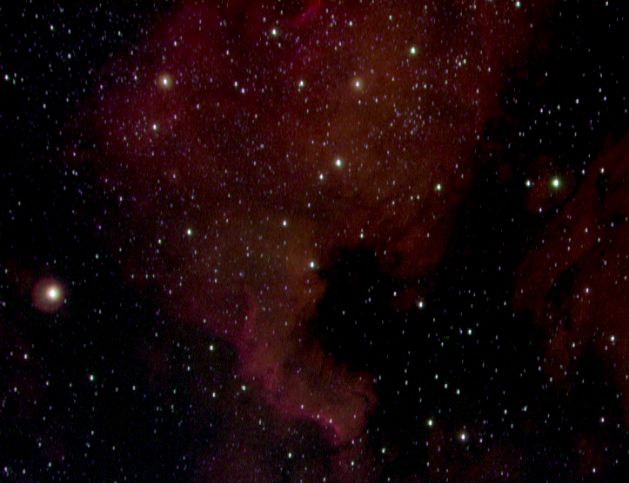

NGC 7000, in the constellation of Cygnus, is an emission nebula that derives its name from its shape. It has a visual magnitude of 4, so should be visible to the unaided eye as a slightly brighter patch of the Milky Way, which passes through this region. It is certainly visible in binoculars in dark skies or with the aid of light-pollution filters. However its surface brightness is only 12.6 so it is a dim object in the telescope. The picture below needed two-minute exposures through narrow-band filters. Its distance from us is uncertain but believed to be between 1800 and 2500 light years. It is also uncertain which star is responsible for exciting the atoms in this nebula. A possible candidate is Deneb (α-Cygni) which is about 3¾° away. At a distance of 2000 light years this would correspond to a true distance of 130 light years, but Deneb is a very powerful star, at least 160,000 times that of the Sun.
 |
This picture was made from pictures taken with Hα, OIII, and SII filters. The light from Hydrogen is red, that from Oxygen is green and that from Sulphur is dark red, so I have assigned the Hα picture to red, the OIII picture to green and the SII picture to blue. As you can see the predominant emission comes from Hydrogen and in fact the nebula was hardly visible in the light from Oxygen and Sulphur. On the right of this picture is a part of another emission nebula, known as the Pelican Nebula (IC5070). These are both part of the same molecular cloud, and the separation of the Gulf-of-Mexico shape are caused by dark material between us and it. (A picture combining this picture with my picture of the Pelican Nebula can be seen here. The bright star on the left is ξ-Cygni of magnitude 3.7 and the halo round it is probably an optical defect. I was encouraged by my good friend Jan to use his selective-stretch technique to enhance this picture further. I have done so but fear I may have overdone it. Move your mouse pointer over the image to see it. Date and Time: 26th June 2010 23:56 to 00:41 UT Camera: MX716 Telescope: 135mm SLR lens at f/4 with narrow-band filters Capture: star_mx7. 5 frames, 120" exposure Processing: star_mx7. Background, non-linear stretch 25. Registax. Stacked 9 or 10 frames at each wavelength, gamma 1.7. Three pictures aligned and output as bitmaps. Colour picture combined in Photoshop and gamma increased to 1.3 in PhotoImpact. |
Home Back to DSOs